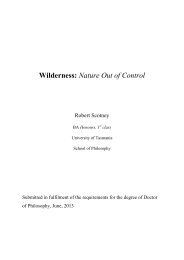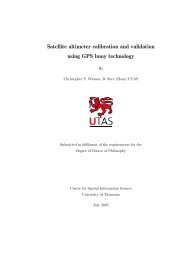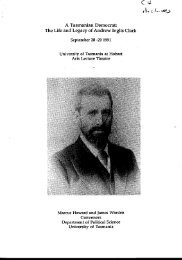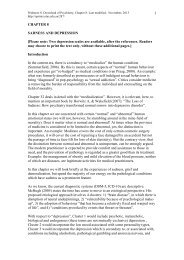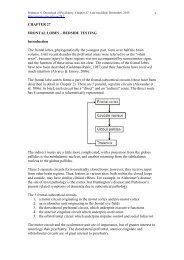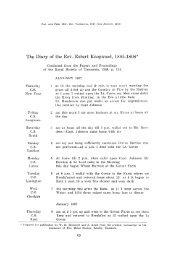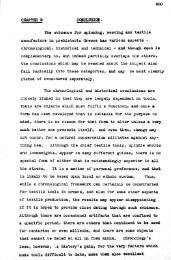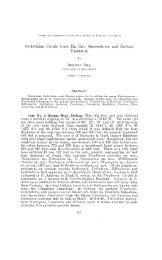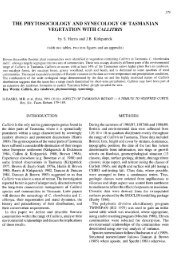Chapter 5 HALLUCINATIONS Hallucinations are ... - UTas ePrints
Chapter 5 HALLUCINATIONS Hallucinations are ... - UTas ePrints
Chapter 5 HALLUCINATIONS Hallucinations are ... - UTas ePrints
Create successful ePaper yourself
Turn your PDF publications into a flip-book with our unique Google optimized e-Paper software.
Pridmore S. Download of Psychiatry, <strong>Chapter</strong> 5. Last modified: November, 2013.<br />
http://eprints.utas.edu.au/287/<br />
1<br />
<strong>Chapter</strong> 5<br />
<strong>HALLUCINATIONS</strong><br />
<strong>Hallucinations</strong> <strong>are</strong> false sensory perceptions. Perception is the process of converting<br />
physical stimulation, such as light waves arriving at the eye or airwaves arriving at the<br />
ear, into psychological information.<br />
<strong>Hallucinations</strong> <strong>are</strong> false sensory perceptions - perceptions in the absence of external<br />
stimuli. For example, hearing voices or seeing people when no one else is present.<br />
<strong>Hallucinations</strong> may result in secondary delusions - they may lead in inaccurate<br />
“explanations” of what is happening.<br />
“<strong>Hallucinations</strong>” in healthy people<br />
Similar phenomena may be experienced in the absence of mental disorder. These<br />
experiences have been recorded over thousands of years.<br />
Let us not offend people – but the religious traditions do mention similar phenomena.<br />
Voices of secular origin have also been experienced by many prominent people. Sigmund<br />
Freud, the father of psychoanalysis wrote, “During the days when I was living alone in a<br />
foreign city….I quite often heard my name suddenly called by an unmistakable and<br />
beloved voice….” The hearing of a family member’s voice when separated from them is<br />
not uncommon among recently bereaved people and those lost in the wilderness. In such<br />
circumstances being alone and wishing to be with loved individuals appears to have<br />
greater explanatory power than supernatural factors and mental disorders.<br />
Mahatma Gandhi relied on an “inner voice” for guidance. Toward the end of his life the<br />
voice said, “You <strong>are</strong> on the right track, move neither to your left, nor right, but keep to<br />
the straight and narrow.” Other people of great resolve have described similar “inner<br />
voices”.<br />
Healthy, more ordinary individuals may hear voices. Professor Henry Sidgewick<br />
conducted the “International Census of Waking <strong>Hallucinations</strong> in the Sane”, in the 1890s.<br />
Seventeen thousand people from England, Russia and Brazil were surveyed. Nearly 10%<br />
reported they had experienced an unexplained perception; 2.9% of the total reported<br />
having heard a voice. A century later Professor Allen Tien conducted a study of 15 000<br />
members of the general population in the USA and found that 2.3% had heard voices<br />
(Tien A, 1991). A recent review of publications about “voice-hearing” by healthy<br />
individuals was frustrated by the different definitions employed and the very wide ranges<br />
reported, but found a median of 13.2% (Beavan et al, 2011).
Pridmore S. Download of Psychiatry, <strong>Chapter</strong> 5. Last modified: November, 2013.<br />
http://eprints.utas.edu.au/287/<br />
2<br />
<strong>Hallucinations</strong>, usually of the name being called, <strong>are</strong> sometimes heard by healthy people<br />
as they pass from waking to sleeping (hypnogogic) and from sleeping to waking<br />
(hypnopompic hallucinations).<br />
Thus, healthy people may, from time to time, hear voices. C<strong>are</strong> has been taken in these<br />
paragraphs to avoid calling these experiences, hallucinations, even though these<br />
experiences satisfy the technical definition.<br />
Briefly, there <strong>are</strong> usually differences between the voices heard by healthy individuals and<br />
the hallucinations of those with mental disorders. In healthy individuals, the voice is<br />
usually as if from one person, speaking comprehensibly, in a helpful and comforting<br />
manner. Auditory hallucinations in mental disorders, in contrast, may involve more than<br />
one voice, sometimes arguing, sometimes commenting about the patient, frequently<br />
making little sense, often in a threatening or frightening manner.<br />
<strong>Hallucinations</strong> associated with non-mental disorder conditions<br />
Frederic Chopin experienced hallucinatory episodes throughout his life: a case has been<br />
made that these were a feature of epilepsy (Vazqez & Branas, 2011).<br />
Charles Bonnet syndrome is the experience nonthreatening visual hallucinations in<br />
patients who <strong>are</strong> free of neurological and psychiatric disorder, who have significant<br />
visual impairment secondary to ocular disease (Jackson & Madge, 2011). Other forms of<br />
sensory deprivation and fatigue may also lead to hallucinations.<br />
<strong>Hallucinations</strong> occur in Neurocognitive disorders – most frequently in Dementia with<br />
Lewy Bodies and Parkinson’s disease dementia (Ballard et al, 2013).<br />
Illegal drug use is commonly motivated by the desire to experience hallucinations and<br />
illusions (visual, auditory, somatic, tactile; Cruz & Dominguez, 2011).<br />
<strong>Hallucinations</strong> may also occur with some medically prescribed medications, for example,<br />
the anaesthetic drug ketamine, and some of the drugs used in the treatment of Parkinson’s<br />
disease. With illegal hallucinogen use, hallucinations <strong>are</strong> desired and achieved; less<br />
desired <strong>are</strong> those of Hallucinogen Persisting Perception Disorder, a condition which may<br />
appear when use has ceased. <strong>Hallucinations</strong> may occur with many brain disorders<br />
including tumour, multiple sclerosis and dementia. In the conditions mentioned in this<br />
section, visual hallucinations <strong>are</strong> the most common.<br />
<strong>Hallucinations</strong> in mental disorders<br />
Pathological hallucinations take many forms.
Pridmore S. Download of Psychiatry, <strong>Chapter</strong> 5. Last modified: November, 2013.<br />
http://eprints.utas.edu.au/287/<br />
3<br />
Auditory hallucinations <strong>are</strong> usually of voices. However “non-verbal” auditory<br />
hallucinations do occur, and include clicking and mechanical noises, muttering or<br />
mumbling, and music. (In musical hallucinations the patient often hears a complete piece<br />
of music.) Auditory hallucinations <strong>are</strong> most common in psychotic disorders such as<br />
schizophrenia, but can occur in other disorders including mood disorders, organic mental<br />
disorders and of course, drug induced states.<br />
In the case of verbal auditory hallucinations (voices), these may be heard inside or<br />
outside the head. [Voices inside the head <strong>are</strong> associated with better patient<br />
insight/understanding of their condition, than voices hear outside the head (Lera et al,<br />
2011).]<br />
One or more than one different voice may be heard. In the case of more than one, these<br />
can be heard sequentially or simultaneously. Two or more voices may conduct a<br />
conversation between themselves. A voice or voices may speak to the patient or about the<br />
patient. They may comment on his or her thoughts or actions. Voices <strong>are</strong> usually heard as<br />
speaking, but they may be heard singing or shouting. Voices r<strong>are</strong>ly speak in complete<br />
sentences - they usually say a few disjointed words in brief utterances. While the content<br />
of auditory hallucinations may be understood by the patient, frequently it is not.<br />
The patient may recognize the voice because it has been heard before, either first hand or<br />
via the media. Voices usually do not introduce themselves, e.g., “This is God speaking”,<br />
is almost never heard. It may be that the patient has never heard the voice before, but<br />
nevertheless “knows” who is speaking. It is often God, Jesus, Satan, a member of a<br />
covert spy agency, criminals or the leader of a bikie gang. Voices can be from relatively<br />
benign sources such as a former next-door neighbour, but they <strong>are</strong> almost never from<br />
kindly disposed individuals such as a favourite early school teacher, Mary Poppins or<br />
Peter the Rabbit.<br />
Illustration. This note was pushed under the office door of the author, by a known patient.<br />
There had been a good patient-doctor relationship. The patient began to hallucinate the<br />
author’s voice at night. While there had been a good patient-doctor relationship, the last<br />
line “Leave me alone!” suggests irritation. It is easy to understand how uninvited,<br />
disturbing voices may be resented. On the other hand, voices (even insulting ones) may<br />
become “company” for the isolated individual, in which case they may become welcome.
Pridmore S. Download of Psychiatry, <strong>Chapter</strong> 5. Last modified: November, 2013.<br />
http://eprints.utas.edu.au/287/<br />
4<br />
Voices may instruct or command the patient to perform an act. Usually this is a trivial act<br />
such as making a cup of tea, but it may be to injure him/herself or others. Importantly,<br />
patients do not automatically comply with command hallucinations. When a command is<br />
first given, the words <strong>are</strong> usually spoken, perhaps with a hint of insistence. For some<br />
patients, when command hallucinations <strong>are</strong> ignored, there <strong>are</strong> no consequences, the<br />
command is not repeated, or may be repeated essentially in the same relatively benign<br />
manner. In these conditions the patient is able to continue with his or her activities. In<br />
other cases, however, when commands <strong>are</strong> ignored, they <strong>are</strong> repeated with much<br />
insistence, perhaps shouted with abuse. Generally, patients do not like complying with<br />
command hallucinations, perhaps because to do so threatens their sense of autonomy.<br />
However, it is very distressing to be subjected to repeated, raised, abusive voices. A<br />
common response of patients is to comply with the trivial commands such as, “Look out<br />
of the window”, and to resist the uncomfortable or dangerous ones such as, “Jump out of<br />
the window”. Command hallucinations <strong>are</strong> not a common factor in homicide.<br />
Illustration. In forty years in clinical practice, the author has known only two or three<br />
cases in which a person with hallucinations telling him/her to seriously injure him/herself<br />
has done so. This is one; a man with schizophrenia was instructed to chop his arm off.<br />
Verbal hallucinations may be a feature of elevated or depressed mood. In the case of<br />
elevated mood the hallucination may assert the patient has exceptional beauty,<br />
intelligence or other qualities: “We know you’re the king”. In the case of depressed mood
Pridmore S. Download of Psychiatry, <strong>Chapter</strong> 5. Last modified: November, 2013.<br />
http://eprints.utas.edu.au/287/<br />
5<br />
the hallucinations may denigrate, “You rat. You should die”. They may suggest or<br />
command suicide. The patient may comply, but usually resists.<br />
Visual hallucinations may occur in a range of disorders. They occur more frequently than<br />
auditory hallucinations in people with neurological disorders. In some types of epilepsy<br />
visual hallucinations may form complex scenes such as two trucks and a rickshaw driving<br />
through the room. In migraine, a common disorder of people who do not have a mental<br />
disorder, visual hallucinations may have the form of circles or lines in space across the<br />
visual field. In schizophrenia, visual hallucinations <strong>are</strong> often indistinct or distinct figures,<br />
often humanoid, standing to one side of the patient.<br />
Illustration. This note was written by a man with schizophrenia. It tells of seeing a visual<br />
hallucination of “a missile as plain as I see you”. In schizophrenia, detailed visual<br />
hallucinations such as this <strong>are</strong> much less common than auditory hallucinations.<br />
Tactile hallucinations <strong>are</strong> the experience of being touched or of a crawling sensation<br />
under the skin. These <strong>are</strong> common in drug withdrawal states, but may occur in<br />
schizophrenia.<br />
Somatic hallucinations <strong>are</strong> the sensation of things happening inside the body, such as<br />
organs moving from one part of the body to another. These <strong>are</strong> r<strong>are</strong>, but may occur in<br />
schizophrenia.<br />
Gustatory/Olfactory hallucinations, the hallucinations of taste and smell, <strong>are</strong> more<br />
common in neurological disorders, particularly epilepsy, but may occur in schizophrenia.<br />
A recent study (Langdon et al, 2011) found olfactory hallucinations in 15% of patients<br />
with schizophrenia, and some patients with social anxiety and depression. The authors
Pridmore S. Download of Psychiatry, <strong>Chapter</strong> 5. Last modified: November, 2013.<br />
http://eprints.utas.edu.au/287/<br />
6<br />
suggested that people <strong>are</strong> more reluctant to talk about smells than voices, and that this<br />
type of hallucination may be more common than is generally accepted.<br />
Autoscopic (self see) hallucinations <strong>are</strong> the visual experience of the subject/patient<br />
seeing an image of him/herself (or parts of him/herself). This is a r<strong>are</strong> symptom which<br />
takes many forms, and is mentioned only as a curiosity – no student will fail an exam<br />
through unfamiliarity with autoscopic hallucinations.<br />
Brugger et al (1997) reviewed the literature and developed a classification containing 6<br />
types: 1) only parts of the double <strong>are</strong> seen (e.g., face, torso), 2) the double is complete<br />
(this is the “doppelganger” which appears in folklore and literature), 3) the feeling of a<br />
presence (no double is actually “seen”), 4) out-of-body experience (the individual is<br />
outside and looks back at their own body), 5) negative autoscopy (the individual is unable<br />
to see their own body either when looked at directly, or in a mirror), and 6) inner<br />
(internal) autoscopy (the inner organs <strong>are</strong> seen outside the body).<br />
Autoscopic hallucinations occur more frequently in neurological disorders (Dening &<br />
Berrios, 1994), but can occur in psychotic disorders and stressful situations.<br />
Illusions <strong>are</strong> perceptions that <strong>are</strong> associated with an outside stimulus, but the stimulus is<br />
wrongly interpreted. For example, lapping water may be heard as laughter. Technically,<br />
illusions <strong>are</strong> not hallucinations, because they <strong>are</strong> associated with a stimulus. Illusions <strong>are</strong><br />
frequently visual, and they <strong>are</strong> usually the result of a neurological disorder. The condition<br />
which most commonly causes illusions is delirium tremens (DTs), the disturbed state<br />
which can complicate alcohol withdrawal. Objects such as creases in bed covers may be<br />
perceived as snakes, insects or other animals. Folk law says that people in DTs see “pink<br />
elephants”. In clinical practice, however, small organisms <strong>are</strong> more commonly “seen”.<br />
Other perceptual difficulties include heightened and changed perceptions. By<br />
heightened perceptions is meant sounds seem unnaturally clear, loud or intense, colours<br />
appear more brilliant or beautiful, or details of the environment seem to stand out in a<br />
particularly interesting way. By changed perceptions is meant changes <strong>are</strong> perceived in<br />
the shape or size of people and inanimate objects in the environment. Changes may<br />
continue while the patient watches. These phenomena may occur in psychotic disorders;<br />
on occasions psychotic patients may be difficult to engage in conversation because they<br />
<strong>are</strong> concentrating on continuously changing perceptions. Patients may spend long periods<br />
looking in a mirror, watching their own face change. Heightened and changed<br />
perceptions may occur in other disorders, including the non-psychotic, anxiety disorders.<br />
Summary: Circumstances and disorders associated which hallucinations.<br />
<strong>Hallucinations</strong> <strong>are</strong> common in schizophrenia. They occasionally occur in the elevated<br />
phase of bipolar disorder and in very severe (psychotic) depression. The hallucinations of<br />
these mood disorders <strong>are</strong> usually auditory. In the elevated state, voices usually state that<br />
the individual has extraordinary skills or beauty, in the depressed phase voices usually<br />
denigrate or accuse the patient of reprehensible acts.
Pridmore S. Download of Psychiatry, <strong>Chapter</strong> 5. Last modified: November, 2013.<br />
http://eprints.utas.edu.au/287/<br />
7<br />
“Normal <strong>Hallucinations</strong>”<br />
Religious experiences, often in group settings<br />
Sleep deprivation, voluntary or forced<br />
Sensory deprivation (Charles Bonnet Syndrome)<br />
Bereavement<br />
Hypnogogic and hypnopompic<br />
Drug Induced<br />
Illegal drugs, LSD, volatile substances<br />
Legal drugs, Ketamine, Parkinson’s disease treatments<br />
Drug Withdrawal<br />
Alcohol – these <strong>are</strong> generally illusions rather than hallucinations<br />
Neurological Disorders<br />
Temporal lobe epilepsy<br />
Various others, uncommon: multiple sclerosis, brain tumour<br />
Mental Disorders<br />
Schizophrenia, usually voices, but other types also<br />
Mood elevation (mania) not common<br />
Mood depression, in severe forms only.<br />
Table. Circumstances and disorders in which hallucinations may be experienced.<br />
Neuroimaging<br />
<strong>Hallucinations</strong> in schizophrenia have been studied using a range of neuroimaging<br />
techniques.<br />
Not surprisingly, both the Wernicke (left superior temporal gyrus; STG) and the Broca<br />
(left inferior frontal gyrus; IFG) speech <strong>are</strong>as have both been implicated. In groups of<br />
people with schizophrenia who experience auditory hallucinations, a significant reduction<br />
in the volume of the left STG has been demonstrated (Sun et al, 2009). Also, significantly<br />
increased activity has been demonstrated in left STG, IFG, the anterior cingulate cortex,<br />
the parahippocampal gyrus (Allen et al, 2008; Northoff & Quin, 2011).<br />
Recent theory is that the auditory hallucinations in schizophrenia <strong>are</strong> due to disruption of<br />
connections between the frontal and termporo-pariental language <strong>are</strong>as. Using diffusion<br />
tensor imaging (DTI) and magnetic transfer imaging (MTI), de Weijer et al (2011)<br />
studied the arcuate fasciculus and 3 other white matter tracts (cortical spinal tract,<br />
cingulum, and uncinate fasciculus) in people with schizophrenia and severe<br />
hallucinations. Consistent with theory, they found abnormalities in all fibre tracts, and a<br />
correlation with both DTI and MTI findings in the arcuate fasciculi and the severity of<br />
positive symptoms.
Pridmore S. Download of Psychiatry, <strong>Chapter</strong> 5. Last modified: November, 2013.<br />
http://eprints.utas.edu.au/287/<br />
8<br />
The following 2 illustrations <strong>are</strong> presented as a reminder of the anatomy of these tracts –<br />
they <strong>are</strong> not taken from research on hallucinations.<br />
Illustration: the superior longitudinal fasciculus (of which the arcuate fasciculus is an<br />
anterior component), the cingulum, and the uncinate fasciculus.<br />
Illustration: This diffusion tensor imaging (DTI) image (generously provided for public<br />
use by Aaron G. Filler, MD, PhD) shows the right and left arcuate fasciculus (Raf & Laf),<br />
and the right and left superior longitudinal fasciculus (Rslf & Lslf) as separate entities<br />
(they can be conceptualized as continuous).<br />
In other recent work, Horga et al (2011) studied first-presentation, drug-free patients with<br />
schizophrenia. Using positron emission tomography (PET), they comp<strong>are</strong>d patients with<br />
commenting auditory hallucinations to patients without auditory hallucinations. Patients<br />
with auditory hallucinations demonstrated significantly increased metabolic rates in the<br />
left superior and middle temporal cortices, bilateral medial frontal cortex and the left<br />
caudate nucleus. In addition, there was decreased activity in the hippocampalparahippocampal,<br />
cerebellar and parietal cortices during hallucinations.<br />
This work suggests that failure to deactivate the temporal cortex allows increased<br />
spontaneous activity, and auditory hallucinations. It is possible that decreased activity in
Pridmore S. Download of Psychiatry, <strong>Chapter</strong> 5. Last modified: November, 2013.<br />
http://eprints.utas.edu.au/287/<br />
9<br />
hippocampus-parahippocampal gyrus and possibly the cerebellum allows the increased<br />
spontaneous activity of the temporal cortex. Horga et al (2011) drew attention to a<br />
possible central role for the caudate, in auditory hallucinations.<br />
Recent work (Amad et al, 2013) suggests abnormal connectivity patterns, involving the<br />
hippocampus, in people with schizophrenia and visual hallucinations.<br />
Case histories<br />
Case history: 1<br />
Cynthia Campbell was 17 years of age and attended a local Catholic school. She lived<br />
with her p<strong>are</strong>nts and 15 year old sister, Melissa, in a middle class suburb of a large city.<br />
Her only other sibling, Libby, was older, in the Army, and stationed overseas. Cynthia’s<br />
mother was a dentist and her father was a fireman.<br />
Cynthia had been distressed. She was about to leave high school but didn’t have a clear<br />
plan for the future. She had found schoolwork difficult, and although she had<br />
daydreamed about becoming a teacher and helping children like herself, who had<br />
struggled, she was adamant that she would not go to university. She liked the idea of a<br />
job in a plant nursery. That would mean a part-time Technical College course, but she<br />
thought she could probably manage. She knew some sort of qualification was essential<br />
for a comfortable working life. The problem was that jobs were few and far between. If<br />
all else failed, she could join the Army, like Libby. Although, her father had said he<br />
didn’t want her to go in that direction.<br />
She had just broken up with Sam, an 18 year old who was attending a different school.<br />
She had loved him, he was her first intimate lover, but he had found someone else.<br />
When she was going out with Sam she started smoking some marihuana at parties on<br />
Saturday nights. On one occasion she took one “speed” (amphetamine/stimulant) tablet.<br />
Since the break-up she had sought a supplier of marihuana and had smoked after school<br />
two or three times a week.<br />
A week ago, when she was smoking at her girl-friends house she heard her father’s voice.<br />
She quickly stubbed her “joint” out, grabbed Emily’s joint and stubbed that out, pushed<br />
the ashtray under the bed, and pretended to be reading a magazine. Emily looked at her<br />
quizzically, “What’s up your knickers?” she asked.<br />
“Shhh. My father’s out there,” Cynthia replied, flapping her magazine to disperse the<br />
residual smoke. For a moment, Emily was startled,<br />
“How do you know?” she whispered.<br />
It soon became clear that Mr. Campbell was not in or near the house.<br />
“I just thought I heard his voice,” said Cynthia, making an effort to sound nonchalant.
Pridmore S. Download of Psychiatry, <strong>Chapter</strong> 5. Last modified: November, 2013.<br />
http://eprints.utas.edu.au/287/<br />
10<br />
A week later, while the family was having dinner, “That’s Libby…. She must be home!”<br />
Cynthia interrupted, dropping her cutlery and standing up from the table. She turned as if<br />
to run out of the room, but froze, standing, listening.<br />
“I didn’t hear anything,” said her father.<br />
“No. It couldn’t be,” said her mother. “She didn’t say she was coming.”<br />
“Yes. Yes it is,” said Cynthia. She continued to listen.<br />
Then they all went quiet and listened. Only Cynthia heard something.<br />
There was a common sense of alarm. There was something wrong. Melissa was<br />
frightened and cowered down into her chair. Her p<strong>are</strong>nts stood up, not quickly, as when<br />
faced by an attacker, but questioningly. Cynthia’s expression changed from surprise and<br />
pleasure to bewilderment, through some level of comprehension to terror.<br />
“What’s happening! What’s happening!” she wailed, and began crying. Her p<strong>are</strong>nts took<br />
her from the table to the sofa and sat on either side.<br />
Cynthia’s experience was of a voice from outside her head, which she heard. She could<br />
not say if it was a male or a female voice, but she heard her name clearly called. There<br />
were some other words and short sentences, most of which were muffled. What she heard<br />
did not seem to make much sense. As when she had heard her father’s voice at Emily’s<br />
house, the experience was totally convincing, but once it stopped Cynthia could agree,<br />
she had been mistaken. That is, she lacked insight while she was hallucinating, but she<br />
gained insight into her situation when the hallucination stopped and she was able to check<br />
with her companions.<br />
Learning that this was the second of these events, and distressed by her distress,<br />
Cynthia’s p<strong>are</strong>nts insisted that she stay at home and rest the next day, which was<br />
Saturday. That morning she saw a palomino horse walk through the kitchen wall, turn left<br />
and walk down the hall before disappearing. She was calm and interested in the sight<br />
while this was happening, but terrified when it was over. She sensed that she had lost<br />
control over her mind and her environment.<br />
Cynthia’s palomino horse experience startled her p<strong>are</strong>nts. They immediately arranged for<br />
her to see a general practitioner. They thought the roots of the problem may have been<br />
the break-up of her relationship with Sam and the pressure she was under to make<br />
decisions about what she wanted to do in life. Secretly, her father thought she could be<br />
pregnant. The general practitioner thought schizophrenia was the most likely diagnosis. A<br />
possibility which avoided them all was drug induced hallucinations.<br />
A series of investigations were performed, including an electroencephalogram (EEG;<br />
attaching electrodes to the head to measure the electrical activity of the brain). The EEG<br />
revealed Cynthia was suffering a form of epilepsy. She was treated with medication for<br />
epilepsy and advised to avoid illegal drug. The hallucinations ceased. Epilepsy is<br />
associated with a physical brain abnormality, but can be worsened by emotional stress<br />
and the use of certain drugs, particularly mind-altering substances.
Pridmore S. Download of Psychiatry, <strong>Chapter</strong> 5. Last modified: November, 2013.<br />
http://eprints.utas.edu.au/287/<br />
11<br />
Case history: 2<br />
Michael Wells was a twice married chef of 29 years of age. He lived with Holly, his<br />
second wife and her child from another relationship, in an inner Sydney tenement house.<br />
He had a son, Ned, from his first marriage; he r<strong>are</strong>ly saw the boy as his ex-wife had<br />
moved interstate. Michael had a good job at a chef in a restaurant near his home.<br />
“You’re not getting sick again, <strong>are</strong> you?” asked Bob, without smiling, as he pinned<br />
another order on the board.<br />
“Absolutely not! Why? What’s the problem?”<br />
Five years ago Michael had suffered an attack of schizophrenia. He had the delusion that<br />
Ned was going to be sold by his ex-wife, and hallucinations of voices and sirens. The<br />
most disabling symptom, however, had been his inability to think clearly. His thoughts<br />
kept slipping off track. He could not orchestrate his cooking, he could not get everything<br />
coming together and ready to serve at the same time. He would start thinking about one<br />
dish and then be distracted by another, and then another, and in the end, they would all be<br />
spoiled. Bob had very kindly kept Michael’s job open for three months, till he had<br />
recovered and was able to return to work. But now there was a note of apprehension and<br />
irritation in his voice, which suggested he would be reluctant to do the same again.<br />
“You’re slow today. We’ll talk about it later,” Bob said over his shoulder, as he went<br />
back out to smile and greet and reassure people that their meals were well in hand.<br />
Michael shook his head as if to clear it of sleep, and the look of concentration on his face<br />
increased. He pushed on, “Fuck off, fuck off, fuck off, fuck off…” he muttered, like a<br />
muted machine gun, to himself, from time to time. But not when Bob was in the kitchen.<br />
Michael’s output increased and the promised discussion did not eventuate.<br />
He got an earlier appointment with his psychiatrist.<br />
“I need to go back to the higher dose,” he said.<br />
One month earlier, Michael had wanted to stop his medication. He discussed this with his<br />
psychiatrist. He made the point that he had been well for five years and that his<br />
medication had side effects: it reduced his sexual drive and made him tired. His doctor<br />
said that he was still at risk of a recurrence of acute schizophrenia, that things were going<br />
well for him, and that his relationship and his job could be at risk if he got sick again. In<br />
the end they decided it would be reasonable, in the first instance, to reduce his medication<br />
by half, and to reassess the situation in a month or so.<br />
Michael found that he had felt much better on the reduced dose. He had more energy and<br />
he felt as if he was making progress. There had been no delusions and his thinking was<br />
still clear. The auditory hallucinations, however, had returned. He had two voices, both<br />
male. Sometimes they seemed to be outside his head, sometimes they seemed to be<br />
inside. It was similar to when he was sick, and he had known they were hallucinations<br />
from the day they came back, a week ago. Although he knew they were illness symptoms
Pridmore S. Download of Psychiatry, <strong>Chapter</strong> 5. Last modified: November, 2013.<br />
http://eprints.utas.edu.au/287/<br />
12<br />
and not “real”, it was hard not to listen to them, and they distracted him from what he was<br />
doing. They often commented on what he was doing and told him what to do. They<br />
sometimes got loud, insistent and abusive if he failed to comply.<br />
“He’s separating the egg white,” one voice might say, when he was separating egg white<br />
for a sweet. Michael would find himself listening, to see if they were going to say what<br />
he should do next. It was comforting, in a way, they were company, even flattering. But<br />
then,<br />
“Add a teaspoon of water,” they might say. If a teaspoon of water was not a good idea,<br />
and he failed to comply, the voices, which usually spoke separately, might speak in<br />
unison.<br />
“Hey! Add a teaspoon of water!”<br />
If he still failed to comply, the voices might shout (sometimes Michael was concerned<br />
that folks sitting in the restaurant would hear) and add insulting words.<br />
“ADD SOME WATER, YOU FUCKING PRICK!”<br />
On occasions, even though he knew they were hallucinations, he would comply, just to<br />
shut them up. He resisted if their commands would ruin the meal, and thereby, his<br />
reputation.<br />
The Psychiatrist explained that staying on the half dose of medicine had prevented a full<br />
relapse with loss of insight, but that there was now an immediate risk of a full relapse,<br />
which would probably mean further hospitalization. This warning was unnecessary.<br />
Michael’s recognized that his reduced productivity was threatening his job and returned<br />
to the higher dose of medication. The hallucinations quieted, then disappe<strong>are</strong>d. He never<br />
had that talk with Bob. A year later he took Holly and his stepdaughter over the border to<br />
visit Ned.<br />
Case history: 3<br />
Pho Robertson was a 51 year old Australian citizen who was born in Vietnam. Her<br />
husband, Bill, died of an unexpected heart attack, two months previously. She lived in a<br />
comfortable four-bedroom home in a middle class suburb of Sydney. They had two<br />
children, both now married: Janice was in the Australian Embassy in Washington and<br />
Ken was unemployed and lived to surf.<br />
Pho, the daughter of a schoolteacher and his wife, was raised in Saigon (Ho Chi Minh<br />
City). She had a good education, learning English and French and become a teacher in<br />
her late teens. For reasons which were never clear, her p<strong>are</strong>nts were imprisoned and she<br />
was exiled to a rural district. She did not see her father again; he died or was killed within<br />
a year of being imprisoned. She did not see her mother for another fifteen years.<br />
Bill completed training as a surveyor. He found the last years boring and the thought of<br />
going directly into practice did not appeal. He joined the Army for some excitement. He<br />
was given a commission and was among the first Australian soldiers sent to Vietnam in
Pridmore S. Download of Psychiatry, <strong>Chapter</strong> 5. Last modified: November, 2013.<br />
http://eprints.utas.edu.au/287/<br />
13<br />
1967. He spent much of his time in the field, exposed to the danger of land mines and<br />
enemy fire.<br />
Bill met Pho in a small village close to Nui Dat, the Australian task force base. She was<br />
beautiful; he was afraid. She was sad and fatalistic, but a comfort to him. In spite of his<br />
neediness, he was protective toward her. They talked of marriage, but there would be<br />
huge hurdles. Bill finished his tour of duty and came home. Although psychologically<br />
afflicted by his war experience, he volunteered for a second tour so that they could be<br />
together, at least for small amounts of time.<br />
When he finished his second tour he came home, and Pho followed six months later.<br />
They settled in Bill’s hometown, Brisbane. There were many problems. Bill’s p<strong>are</strong>nts and<br />
siblings were not supportive. Many Australians thought Pho was Chinese or Japanese;<br />
when they learned she was Vietnamese, they behaved as if she was a communist and an<br />
enemy.<br />
Bill and Pho were delighted when the children came along, and they could form their<br />
own complete, if somewhat socially isolated family. When the children were entering<br />
secondary school, Pho’s letter writing paid off and she regained contact with her mother.<br />
Bill had built up his own surveying company, they were doing well financially, and Pho<br />
was able to get the next plane to Vietnam to visit her mother. The old lady would not<br />
leave her native land, so over the years the family went to visit her three times.<br />
Both the children were clever at school. Both had straight black hair and looked part<br />
Asian, but neither spoke of suffering significant racial prejudice. The girl was ambitious<br />
and proud of her heritage. She went to university with the intention of joining the<br />
diplomatic service. Her life had run according to plan. The boy was less ambitious. He<br />
started taking drugs in high school and did not seek further education. He married a<br />
waitress. It was an open secret that the couple made a fair living growing marihuana,<br />
drifting from one coastal town to the next, staying one step ahead of the law.<br />
Bill suffered posttraumatic stress disorder following the war. He felt like a weakling<br />
because Pho’s experiences seemed worse than his, but she had not been damaged. Along<br />
with most other Australian Vietnam War Veterans, Bill felt betrayed by his country. They<br />
had been sent to fight and risk their lives overseas, but on return, they were criticized<br />
rather than appreciated for carrying out their orders. Then, along with others, either out of<br />
guilt or wisdom, Bill got involved in rebuilding Vietnam. Gangs would go, taking tools<br />
and materials, and build a school or orphanage or anything else they could put up in<br />
about a month.<br />
He was buying roofing materials for a dormitory when, at fifty-five, he fell down dead in<br />
a Sydney parking lot.<br />
Pho cried little. The children had come home for a week and she had looked after them.<br />
She was sad, had lost her appetite and had difficulty sleeping. She expected and accepted<br />
these difficulties. She did not expect to ever be happy again, or to eat or sleep well. She
Pridmore S. Download of Psychiatry, <strong>Chapter</strong> 5. Last modified: November, 2013.<br />
http://eprints.utas.edu.au/287/<br />
14<br />
was in a foreign country and had lost the husband who had been her best friend, her<br />
financial supporter and only lover. But, she had not expected hallucinations.<br />
On the night of Bill’s death she did not sleep, she did not go to bed, she sat in the living<br />
room, she had his picture on the coffee table but she st<strong>are</strong>d at the wall. About four in the<br />
morning she heard Bill say,<br />
“Don’t worry sweetheart…We can fix it.”<br />
For a cruel instant, she was bewildered.<br />
“He is alive, it’s a big mistake”, she thought. But then, she realised that Bill was indeed<br />
dead, and thought she must have heard his ghost. Then she concluded that it must have<br />
been a dream, and she must have drifted off to sleep for a moment, without noticing.<br />
Next afternoon, she was sitting in the same chair, staring at the wall. She glanced over at<br />
Bill’s chair, and there he was in his dressing gown reading something. He raised his head<br />
and smiled back at her. He was calm and loving. He went back to his reading. She looked<br />
away, not knowing what to do, when she looked back, he was gone.<br />
Pho heard and saw nothing of Bill in the week the children were at home. Or any other<br />
time when people were around. She only saw him twice more. One Saturday afternoon<br />
she went into their bedroom and he was having his afternoon nap on the bed. She froze.<br />
Not out of fright, but so as not to wake him. She looked at him, he was perfect in every<br />
way. There was grease on his cheek from the lawnmower. After a good long drink of<br />
looking at him she backed out of the room to let him sleep. It felt warm to have him<br />
there. When she went back half an hour later, sadly, he was gone.<br />
The last time she saw him was a week later. She had been to the lawyer to finalize<br />
something she didn’t understand about the company. As she came slowly up the drive, he<br />
was standing on the lawn. Their eyes met and his look of concentration softened and he<br />
raised his eyebrows in recognition. She drove into the garage, when she came out, he was<br />
gone.<br />
Pho didn’t believe in ghosts. Vietnamese culture is awash with various deities, but these<br />
experiences did not fit with anything she could accept. She knew little of mental disorder.<br />
In the first few weeks she did not c<strong>are</strong> if she was mad or not. The day before going to the<br />
doctor, she heard Bill speak to her again.<br />
The earth had settled on his grave. She had gone to the stone mason to talk about a<br />
headstone and was undecided about black or red granite. It was something which once<br />
done could not easily be undone. As she sat in the car, after the drive home she heard him<br />
say,<br />
“Black or red? It’s not worth worrying about.”<br />
She looked over to the passenger seat and the back seats, she would have liked to see<br />
him, but he wasn’t there.<br />
“I’m going mad,” she told the doctor. “But, I like hearing his voice. I know I shouldn’t. Is<br />
there something you can do, to stop me getting worse?”
Pridmore S. Download of Psychiatry, <strong>Chapter</strong> 5. Last modified: November, 2013.<br />
http://eprints.utas.edu.au/287/<br />
15<br />
Pho was given reassurance by her doctor and seen twice a week to talk and keep working<br />
through the grieving process. The doctor later recommended Pho spend some time with a<br />
psychotherapist to look at the other losses of her life. At one point she took a small<br />
amount of sedation to help her sleep. Her hallucinations ceased without antipsychotic or<br />
antidepressant medication. Pho eventually visited her daughter in Washington, which she<br />
enjoyed greatly, and on return, she started corresponding with an American Vietnam<br />
veteran.<br />
The hearing or seeing of a close, recently deceased friend or relative is not a mental<br />
disorder. Figures <strong>are</strong> not available, but this is a common experience. Usually these<br />
hallucinations become less frequent and cease over weeks or months. They <strong>are</strong><br />
comforting and benign. Perhaps they have a role in helping the individual adjust to the<br />
loss. Pho was raised in social, political and military turmoil. Although she had been an<br />
adult when she lost her p<strong>are</strong>nts, the circumstances were still damaging. She was<br />
powerless, she did not have reliable information regarding their fate; thus her grieving for<br />
them was disrupted and protracted. She was traumatized by war. She migrated to a<br />
foreign land, peopled by another race, where she experienced prejudice. She was<br />
relatively isolated. Her main social network and support was her family. Her children left<br />
home and the vicinity. When her husband died she lost most of her human contact. While<br />
there is no clear evidence that persons with limited social supports experience more<br />
hallucinations during bereavement than those people with extensive social supports, such<br />
a finding would not be unexpected.<br />
The grieving process is also normal and should not be confused with a depressive<br />
disorder (major depressive disorder of dysthymia). A depressive disorder may, however,<br />
develop following bereavement, and should be considered when the suffering persists for<br />
months or progressively worsens rather than improves.<br />
References<br />
Allen P, Laroi F, McGuire P, Aleman Al The hallucinating brain: a review of structural<br />
and functional neuroimaging studies of hallucinations. Neuroscience Biobehavior Review<br />
2008; 32:175-191.<br />
Amad A, Cachia A, Gorwood P, Pins D, Delmaire C, Rolland B, Mondion M, Thomas P,<br />
Jardri R. The multimodal connectivity of the hippocampal complex in auditory and visual<br />
hallucinations. Molecular Psychiatry 2013 Jan 15 [Epub ahead of print]<br />
Ballard C, Aarsland D, Francis P, Corbett A. Neuropsychiatric symptoms in patients with<br />
dementias associated with cortical Lewy bodies. Drugs Aging 2013; 30:603-11.<br />
Beavan V, Read J, Cartwright C. The prevalence of voice-he<strong>are</strong>rs in the general<br />
population. Journal of Mental Health 2011; 20:281-292.<br />
Brugger P, Regard M, Landis T. Illusory reduplication of one’s own body:<br />
phenomenology and classification of autoscopic phenomena. Cognitive Neuropsychiatry<br />
1997; 2:19-38.
Pridmore S. Download of Psychiatry, <strong>Chapter</strong> 5. Last modified: November, 2013.<br />
http://eprints.utas.edu.au/287/<br />
16<br />
Cruz S, Dominguez M. Misusing volatile substances for their hallucinatory effects: a<br />
qualitative pilot study with Mexican teenagers and a pharmacological discussion of their<br />
hallucinations. Substance Use and Misuse 2011; 46 Suppl 1: 84-94.<br />
Dening T, Berrios G. Autoscopic phenomena. British Journal of Psychiatry 1994;<br />
165:808-817.<br />
Horga G, P<strong>are</strong>llada E, Lomena F, et al. Differential brain glucose metabolic patterns in<br />
antipsychotic-naïve first-episode schizophrenia with and without auditory verbal<br />
hallucinations. Journal of Psychiatry and Neuroscience 2011. DOI: 10.1503/jpn.100085.<br />
Jackson T, Madge S. Acute Charles Bonnet syndrome secondary to eye patching. General<br />
Hospital Psychiatry 2011; 33:303.e1-303.e3.<br />
Langdon R, McGuire J, Stevenson R, Catts S. Clinical correlates of olfactory<br />
hallucinations in schizophrenia. British Journal of Clinical Psychology 2011; 50:145-163.<br />
Lera G, Herrero N, Gonzalez J, et al. Insight among psychotic patients with auditory<br />
hallucinations. Journal of Clinical Psychology 2011; 67:701-708.<br />
Northoff G. Quin P. How can the brain’s resting state activity generate hallucination? A<br />
‘resting state hypothesis’ of auditory verbal hallucinations. Schizophrenia Research 2011;<br />
127:201-214.<br />
Sun J, Maller J, Guo L, Fitzgerald P. Superior temporal gyrus volume change in<br />
schizophrenia: a review of region of interest volumetric studies. Brain Res Rev. 2009;<br />
61:14-32.<br />
Tien A. Distributions of hallucinations in the population. Social Psychiatry and<br />
Psychiatric Epidemiology 1991; 26:287-292.<br />
Vazquez Caruncho M, Branas Fernandez F. The hallucinations of Frederic Chopin. Med<br />
Humanit 2011; 37:5-8.<br />
de Weijer A, Mandl R, Diederen K, et al. Microstructural alterations of the arcuate<br />
fasciculus in schizophrenia patients with frequent auditory verbal hallucinations.<br />
Schizophrenia Research 2011 Jun 3. [Epub ahead of print].



